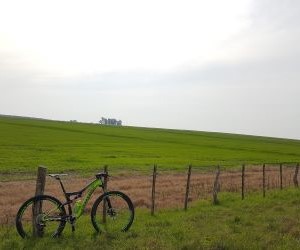Learn how to deal with punctures on long rides with prevention tips, repair techniques, and smart gear choices to keep rolling without stress.
HOW DO I DEAL WITH ALTITUDE SICKNESS WHILE CYCLING?
Altitude sickness can turn a dream cycling adventure into a struggle if not managed properly. As elevation rises, oxygen availability drops, challenging both body and performance. Cyclists often experience fatigue, dizziness, headaches, and reduced power output when riding above 6,000 feet. The good news is that preparation and smart strategies can minimize these effects. This guide explores how altitude impacts cyclists, practical acclimatization methods, nutritional adjustments, and on-the-bike tactics to help you ride stronger and safer at elevation.

What altitude sickness means for cyclists
Cyclists riding at higher elevations encounter reduced oxygen pressure, which limits the body’s ability to deliver oxygen to working muscles. This oxygen deficit not only reduces performance but also triggers acute mountain sickness (AMS), a condition that can strike even seasoned athletes.
Common symptoms to recognize
Recognizing early warning signs is crucial. Altitude sickness often begins subtly but can escalate quickly. Symptoms usually appear within 6 to 24 hours of exposure, especially above 2,000 meters (6,500 feet).
Persistent headache not relieved by hydration.
Dizziness or lightheadedness during or after riding.
Nausea, loss of appetite, or mild stomach upset.
Unusual fatigue or decreased exercise capacity.
Sleep disturbances or restless nights.
Why cyclists are vulnerable
Cycling at elevation adds a double stress: the cardiovascular system works harder to compensate for oxygen deficits while the muscular system demands high output. Even trained athletes can find themselves “hitting the wall” much earlier at altitude. Unlike sea-level fatigue, altitude-related struggles often feel disproportionate to effort, making pacing and planning essential.
Knowing these risks allows cyclists to prepare rather than be blindsided. Proper acclimatization and self-monitoring ensure that altitude enhances the adventure instead of cutting it short.
Proven strategies for prevention
The best way to deal with altitude sickness is to reduce the chance of getting it in the first place. Prevention relies on giving your body time to adapt to reduced oxygen levels, maintaining hydration, and adjusting effort accordingly.
Step-by-step acclimatization
Acclimatization is the gradual process of adjusting to altitude. While some riders may adapt faster than others, the principles remain consistent: ascend slowly and give your body time to catch up.
Arrive a few days early to train lightly at altitude before racing.
Follow the “climb high, sleep low” principle when possible.
Plan incremental gains: no more than 1,000–1,500 feet per day above 8,000 feet.
Allow rest days for adaptation during multi-day tours.
Hydration and nutrition
Altitude accelerates fluid loss through respiration and sweat. Dehydration magnifies symptoms of AMS. Drinking consistently—before thirst hits—is vital. Likewise, carbohydrates become the body’s preferred fuel under hypoxic stress, helping maintain power and recovery.
Drink 3–4 liters of fluids daily with electrolytes for balance.
Prioritize carb-rich meals to support energy demands.
Limit alcohol and excessive caffeine, both of which dehydrate.
Include iron-rich foods to support red blood cell production.
Training adjustments
Pacing becomes critical at high altitude. Power numbers and heart rates recorded at sea level don’t translate directly. Most cyclists should reduce intensity by 10–20% during the first days at elevation. Shorter, controlled rides help adaptation and prevent overexertion that triggers AMS.
Remember, altitude gains come slowly but compound significantly. Over weeks, hemoglobin levels increase, oxygen transport improves, and endurance strengthens. Athletes who respect the process ultimately reap performance dividends.
Practical solutions during rides
Even with preparation, altitude sickness can still strike. Knowing how to manage symptoms while cycling is crucial to safety and performance. Early intervention prevents escalation into severe conditions like high-altitude pulmonary edema (HAPE) or cerebral edema (HACE).
Immediate on-the-bike strategies
If symptoms appear mid-ride, slowing down or pausing is the first step. Reduced intensity allows the body to stabilize. Focus on breathing deeply and rhythmically to maximize oxygen intake.
Stop and rest if dizziness or nausea worsens.
Use controlled breathing: inhale for 3 counts, exhale for 3 counts.
Refuel with carb-dense snacks to combat fatigue.
Hydrate regularly even if you don’t feel thirsty.
When to descend
If symptoms persist or intensify, descending to a lower elevation is the most effective cure. Even dropping 1,000 feet can bring significant relief. Cyclists should never ignore severe headaches, confusion, or shortness of breath—these require immediate descent and possibly medical evaluation.
Long-term adaptation and training benefit
Interestingly, time spent at altitude, while challenging, produces adaptations that benefit sea-level performance. Increased red blood cell production and improved oxygen utilization can enhance future endurance. Cyclists who approach altitude with patience and strategy often return stronger and more resilient.
Ultimately, dealing with altitude sickness while cycling is about balance: respecting physiology, adjusting expectations, and embracing the challenge. With smart preparation and quick responses, riders can turn thin air into a powerful training ally rather than an obstacle.
YOU MAY ALSO BE INTERESTED






